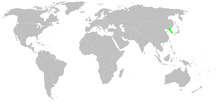| Abeliophyllum | |
|---|---|
 | |
| Scientific classification | |
| Kingdom: | Plantae |
| Clade: | Tracheophytes |
| Clade: | Angiosperms |
| Clade: | Eudicots |
| Clade: | Asterids |
| Order: | Lamiales |
| Family: | Oleaceae |
| Tribe: | Forsythieae |
| Genus: | Abeliophyllum Nakai |
| Species: | A. distichum |
| Binomial name | |
| Abeliophyllum distichum Nakai | |
 | |
Abeliophyllum, the miseonnamu,[2] Korean abeliophyllum,[2] white forsythia, or Korean abelialeaf, is a monotypic genus of flowering plants in the olive family, Oleaceae. It consists of one species, Abeliophyllum distichum Nakai, endemic to Korea, where it is endangered in the wild, occurring at only seven sites. It is related to Forsythia, but differs in having white, not yellow, flowers.
It is a deciduous shrub growing to 1–2 m tall. The leaves are opposite, simple, 6–10 cm long and 3–4.5 cm wide, pubescent both above and below. The flowers are produced in early spring before the new leaves appear; they are white and fragrant, about 1 cm long, with a four-lobed corolla. The fruit is a round, winged samara 2–3 cm diameter.
It is cultivated as an ornamental plant in Europe and North America.
Conservation status
In 1998, a review of the plant's conservation status found that "it is close to extinction and qualifies for the IUCN Category of 'Critically Endangered', indicating a high risk of extinction in the near future.";[3] but as of 2009 it has not yet been formally assessed for the IUCN Red List.
In 2015, IUCN classed the species as endangered.[1]
References
- ^ a b Son, S.-W.; Kim, Y.-S.; Kim, H. (2015-11-01). "Abeliophyllum distichum". IUCN Red List of Threatened Species. 2015-11-01. Retrieved 2016-08-14.
- ^ a b English Names for Korean Native Plants (PDF). Pocheon: Korea National Arboretum. 2015. p. 332. ISBN 978-89-97450-98-5. Archived from the original (PDF) on 25 May 2017. Retrieved 19 December 2016 – via Korea Forest Service.
- ^ Kim, Y. S. & Maunder, M. (1998). "Plants in Peril, 24: Abeliophyllum distichum". Curtis's Botanical Magazine. 15 (2): 141–146. doi:10.1111/1467-8748.00155.
